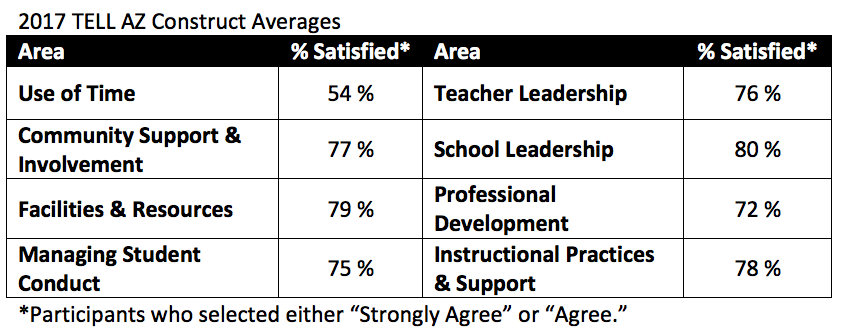Whew! Almost two months have flown by amidst the fast-paced, back-to-school whirlwind. It feels like the 2016-17 school year is history now, but there’s one thing that keeps itching at me from the past: The results from the 2017 TELL AZ Survey that was conducted in April.
For those who’ve already archived their memories from last year, the TELL AZ survey explored teacher satisfaction with working conditions in eight areas: Use of time, community support & involvement, facilities & resources, managing student conduct, teacher leadership, school leadership, professional development, and instructional practices & support. Thirty-one percent of Arizona teachers responded to the survey.
In June, the TELL AZ website published statewide results as well as site-specific reports for schools and districts with qualifying response rates. To give a quick overview of the statewide findings about teacher satisfaction in the eight areas, here’s a snapshot:
During a panel discussion about the results this summer, I was interested when an attendee remarked that, “Arizona teachers seem pretty happy with their overall working conditions.” This comment has been haunting me all summer. When I look at this data, I see a huge problem: Use of time.
Use of time may not seem like a big deal to someone outside the classroom, but these findings speak loudly to me as an Arizona teacher. I constantly struggle with work-life balance because there is not enough time in my paid workday to accomplish my professional responsibilities. Even though I’m happy in other areas of my work life, the enormous workload makes me rethink my profession from time to time. Conversations about workload are common in all my teaching circles. Many educators in Arizona work far beyond their contract hours. Here are the statewide responses to the Use of time questions (courtesy of the TELL AZ website):
Note: Percentages reported include teachers who responded “Strongly Agree” or “Agree.”
Looking at this data indicates many Arizona teachers have inadequate time for professional responsibilities. Perhaps this is especially troubling for the types of individuals who choose teaching as a profession. Almost every teacher I have known has family-oriented values and deep commitments to their own children. In my opinion, these are the exact people we should be attracting to the profession! However, I wonder if this same personality type becomes dissatisfied and disillusioned when their teacher workload directly conflicts with their family values. Speaking from my own experience, my dissatisfaction with the workload increased dramatically when my first child was born. Staying late at work and working at home feels like failure now because I feel like I should be “on top of things” by this stage of my career. In fact, I think the evolving perspectives about Use of time show in the TELL AZ results that were disaggregated by years of teaching experience. The top three graphs in this figure below (courtesy of New Teacher Center) show how Use of Time responses differ between beginning teachers and veteran teachers.
It seems that veteran are less satisfied with the time available than beginning teachers. This graph really interested me because it reflects my own teaching perspectives and comments I hear in the field. When I started teaching, the workload was crushing, but I was driven by a belief that it would get better. In my experience, it’s better but still crushing. Last year, a colleague told me that a new teacher had asked her if the workload gets better and she had told her (kindly) that it really doesn’t. Could the problems with Use of Time be a really big factor in teachers leaving the profession after about three years? Perhaps the types of individuals who are attracted to teaching desire manageable jobs and feel unsatisfied by the teaching workload. I’m drawing some conclusions here, but they are related to my own professional experiences and feelings of workplace satisfaction. I’m curious about how these ideas ring true for other educators. How do our feelings about Use of time affect our overall job satisfaction as teachers in Arizona?
As Arizona policymakers and education advocates consider the TELL AZ data, I hope they will think deeply about how Use of time could improve for teachers in Arizona. Over the summer, I had a real teacher vacation: A position that gave me enough time to get my work done during the workday. Wanna know a secret? I was really, really happy. I enjoyed my time at work, I was surrounded by unstressed colleagues, and I had plenty of time and energy in the evenings. I haven’t had a night like that since we went back to school in August. I think that there are rich teacher stories related to the Use of time aspects of the TELL AZ survey—and I would love to hear your perspectives in the comments below!
For more analysis and discussion about the TELL AZ survey, check out this article on AZED News.
*The TELL (Teaching, Empowering, Leading, and Learning) survey was designed by the New Teacher Center and sponsored in Arizona by organizations including AZK12 Center, Arizona Education Association, Arizona Education Foundation, Arizona Association of School Business Officials, and Arizona School Boards Association.
Image credit: https://i.vimeocdn.com/video/519048855_1280x720.jpg













Comments 12
You nailed it with this: “In my experience, it’s better but still crushing.”
Great article Jess! In order to preserve my time for teaching and preparing for teaching, this year I am reaching out to parents to help out in the class even more, expanding parent duties to include managing field trip chaperones (big load off!). I found a way to lovingly communicate to them that if I don’t get help with specific needs, they won’t happen. I am thankful that they have answered the call.
Awesome way to be aware of all your resources–and MOBILIZE them! What a great benefit, too! No doubt, it will increase parental involvement and connections to your community! Win, win, win!
Hi Jess-
Thank you for sharing this blog. Love that you are looking at the TELL AZ survey data and using it as a platform of sorts. I am curious to see what other educators and teachers reply in regards to time and how it could improve. It seems that it is systemic and must be respected from the top down. From the school board, to district office to schools and teachers.
This totally makes me think about something I wanted to fit into this blog (but didn’t have space!) I completely think that administrators can take some helpful actions to protect teachers and their time. For example, my school is applying for A+ status and I’m on the writing committee. When my principal asked me to help, I agreed because I believe in the school and her leadership. As I said yes, a little part of me worried: “I hope I can find time for this.” Imagine how great it felt when she told our committee that she had budgeted time for subs in case we needed days to work on the application. It meant so much to me because the message was clear: She respects my time, she knows the application will be time consuming, and she’s planned a way to use her resources (like sub money) to help our team accomplish a school goal. If administrators can watch for ways to respect teachers’ time in this way, I think it could make a huge difference for school climate and teacher happiness It made me feel so appreciated and understood!
It made me feel so appreciated and understood!
Jess, I wonder what the impact would be of even small improvements in the data. For example, in some future study I’d love to see a result like, “An increase in 10% of teacher satisfaction in instructional time with students led to an average gain of x points on the Azmerit test.” Now, that would be interesting. Well, all the data are interesting. I just wonder what quantitative impact improvement in the our satisfaction with time use would make.
Such a cool point! I think this is especially important because ultimately, I think teachers are the experts who KNOW what is right for our classrooms. Therefore, if teachers are unsatisfied with working conditions like instructional time with students, I think this could mean that improving this time would indeed also improve student achievement. Perhaps opportunities for comparison will arise after a few years of annual TELL AZ data. I’m looking forward to seeing how the data change over time.
I struggle with work-work balance. By that I mean, how do I balance my time with classroom instruction duties with extra-curricular duties? I LOVE my job, but I often am torn about the amount of time clubs, organizations, and committees takes away from my classroom students. I wish the TELL Survey included a section that dealt with the extra responsibilities many of us take on.
That’s a great point. I work at a school that has a 21st century grant program. Many teachers work after school from 3:30-5:30 with this extra responsibility. There are often emails circulating during the day where teachers are trying to find someone else to cover their 21st century (due to an unexpected conflict). It seems stressful! I also worry about the impact of these types of programs on teachers who have less time after school for lesson planning, grading, prep, etc. Schools have so many responsibilities like you mentioned that require teacher commitments outside the work day. And I have heard that, in most cases, the compensation rarely matches the time investment. The sad part is that teachers care about the kids and know that the extra-curricular activities are important. This is another great example of how teachers time commitments far exceed their work day.
I so relate to this. I know I take on extra responsibilities that are good for my school and students. But how can are carve out time so I can look kids in the eye and have time to work with them? That is my daily struggle. Oh ya, and maybe be a little present at home once in a blue moon!
Crushing…yes. As an 18 year class room teacher, I have not experienced anything getting easier in the workload area. In my experience with policymakers, we have to teach them what our work load reality is like: the hours of planning, grading, paperwork, meetings, etc. that aren’t visible to most people outside the profession. Excellent post!
My cousin used to teach Headstart in Oklahoma City. (She left about three years ago due to the working conditions and pay of her job). In a Facebook post, she talked about how teachers in Oklahoma used to do mass “walk ins” at public places over the weekend where they would sit grading, planning, etc. Their goal was to increase public awareness of their actual work hours. Super interesting, right?!? I definitely think that AZ teachers need to keep the dialogue going about the time commitment outside of work. It’s just a hunch, but I think it’s one of the biggest problems creating attrition (and lack of interest in teaching as a profession).